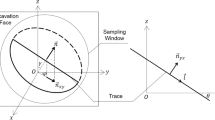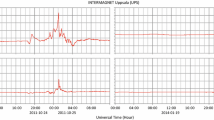Abstract
A comprehensive joint orientation data collection program is necessary to ensure a sufficient degree of confidence in constructing a structural model. This paper investigates the influence of the number of joints sampled on the characterisation of the joint dip and dip direction. In a series of numerical experiments, Discrete Fracture Networks (DFNs) were used to model joint set populations. The average joint properties and the variation of the orientation cluster are obtained by simulating vertical and inclined boreholes in three different DFN models. The confidence level in the joint orientation data is calculated with the confidence limit method for different drilling densities. For comparable joint orientation data variability, a similar trend is observed regarding the confidence level and the number of joint sampled. Based on that trend, a series of recommendations were developed to estimate the number of joint to sample for a single joint set in order to reach a targeted level of confidence in the dip and dip direction data. Depending on the project requirements, the use of a range of levels of confidence and degrees of precision in the recommendations, can provide greater flexibility in design decisions. The proposed recommendations can be used to optimize the planning of geotechnical drilling campaigns for new mining projects or to review an existing structural database for an undergoing project identifying gaps in the data.







Similar content being viewed by others
References
Dershowitz WS, Einstein HH (1988) Characterizing rock joint geometry with joint system models. Rock Mech Rock Eng 21:21–51. https://doi.org/10.1007/BF01019674
Dershowitz WS, Herda HH (1992) Interpretation of fracture spacing and intensity. In: Proceedings of the 33rd U.S. rock mechanics symposium, Santa Fe, New Mexico
Elmo D, Stead D (2010) An integrated numerical modelling-discrete fracture network approach applied to the characterisation of rock mass strength of naturally fractured pillars. Rock Mech Rock Eng 43(3):3–19. https://doi.org/10.1007/s00603-009-0027-3
Esmaeili K, Hadjigeorgiou J, Grenon M (2010) Estimating geometrical and mechanical REV based on synthetic rock mass models at Brunswick Mine. Int J Rock Mech Min Sci 47(6):915–926. https://doi.org/10.1016/j.ijrmms.2010.05.010
Esmaeili K, Hadjigeorgiou J, Grenon M (2013) Stability analysis of the 19A ore pass at Brunswick mine using a two-stage numerical modelling approach. Rock Mech Rock Eng 46(6):1323–1338. https://doi.org/10.1007/s00603-013-0371-1
Fillion M-H, Hadjigeorgiou J (2017) Quantifying the influence of geotechnical borehole inclination on collecting joint orientation data. Min Technol Trans Inst Min Metall Sect A 127(1):26–40. https://doi.org/10.1080/14749009.2017.1308690
Grenon M, Hadjigeorgiou J (2008a) A design methodology for rock slopes susceptible to wedge failure using fracture system modelling. Eng Geol 96(1–2):78–93. https://doi.org/10.1016/j.enggeo.2007.10.002
Grenon M, Hadjigeorgiou J (2008b) Fracture-SG, version 2.17: a fracture system generator software package. Université Laval, Québec
Grenon M, Landry A, Hadjigeorgiou J, Lajoie PL (2017) Discrete fracture network based drift stability at the Éléonore mine. Min Technol Trans Inst Min Metall Sect A 126(1):22–33. https://doi.org/10.1080/14749009.2016.1199296
International Society for Rock Mechanics (1978) Suggested methods for the quantitative description of discontinuities. Int J Rock Mech Min Sci 15(6):319–368
Montgomery DC, Runger GC (2003) Applied statistics and probability for engineers, 3rd edn. Wiley, New York
Priest SD (1985) Hemispherical projection methods in rock mechanics. George Allen & Unwin, London
Read J (2009) Chapter 4: structural model. In: Read J, Stacey P (eds) Guidelines for open pit slope design. CSIRO Publishing, Collingwood
Read J, Stacey P (eds) (2009) Guidelines for open pit slope design. CSIRO Publishing, Collingwood
Rocscience Inc. (2012) DIPS version 6.0, interactive analysis of orientation based geological data. Rocscience Inc., Toronto
Rogers S, Elmo D, Beddoes R (2009) Mine scale DFN modelling and rapid upscaling in geomechanical simulations of large open pits. In: Proceedings of the slope stability conference, 9–11 Nov, Santiago, Chile
Staub I, Fredriksson A, Outters N (2002) Strategy for a rock mechanics site descriptive model. R-02-02. Swedish Nuclear Fuel and Waste Management Company, Stockholm
Wyllie DC, Mah CW (2005) Rock slope engineering, civil and mining, 4th edn. Taylor and Francis Group, New York
Acknowledgements
The authors gratefully acknowledge Anglo American and the Natural Science and Engineering Research Council of Canada for their financial support. The authors are also thankful to Roger Johnson and Phil de Graaf for their useful comments and to Edmar Mandawe for his participation in the analyses.
Author information
Authors and Affiliations
Corresponding author
Rights and permissions
About this article
Cite this article
Fillion, MH., Hadjigeorgiou, J. Recommendations for a Quantitative Description of Joint Orientation Data. Geotech Geol Eng 37, 1503–1514 (2019). https://doi.org/10.1007/s10706-018-0703-8
Received:
Accepted:
Published:
Issue Date:
DOI: https://doi.org/10.1007/s10706-018-0703-8




